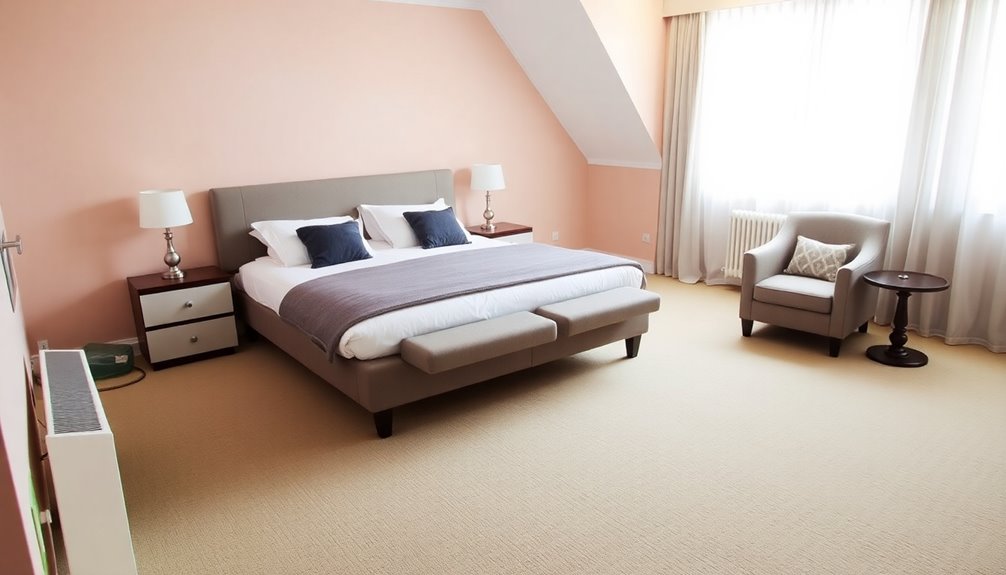When arranging bedroom furniture around baseboard heaters, prioritize safety and airflow. Keep at least 6 inches of clearance to prevent blockage and guarantee efficient heating. Avoid placing flammable materials too close, like bedding or curtains. Consider using furniture with legs to allow air circulation and opt for multi-purpose pieces to save space. Installing vent deflectors can help direct airflow effectively. Regular maintenance is essential—clean your heater to prevent dust buildup. You'll be amazed at how these small adjustments can maximize your room's function and comfort, and there's plenty more helpful tips to explore!
Key Takeaways
- Maintain at least 6 inches of clearance around baseboard heaters to ensure optimal airflow and prevent fire hazards from blocked heat sources.
- Use space-efficient furniture with legs to allow airflow underneath, enhancing heating efficiency and reducing cold spots in the room.
- Consider multi-purpose furniture options to maximize functionality while keeping the space organized and clutter-free around heaters.
- Opt for heat-resistant materials for furniture close to heaters to minimize fire risks and ensure safety in your bedroom layout.
- Regularly clean and inspect heater areas to prevent debris accumulation and maintain effective heating performance throughout the room.
Maintain Clearance
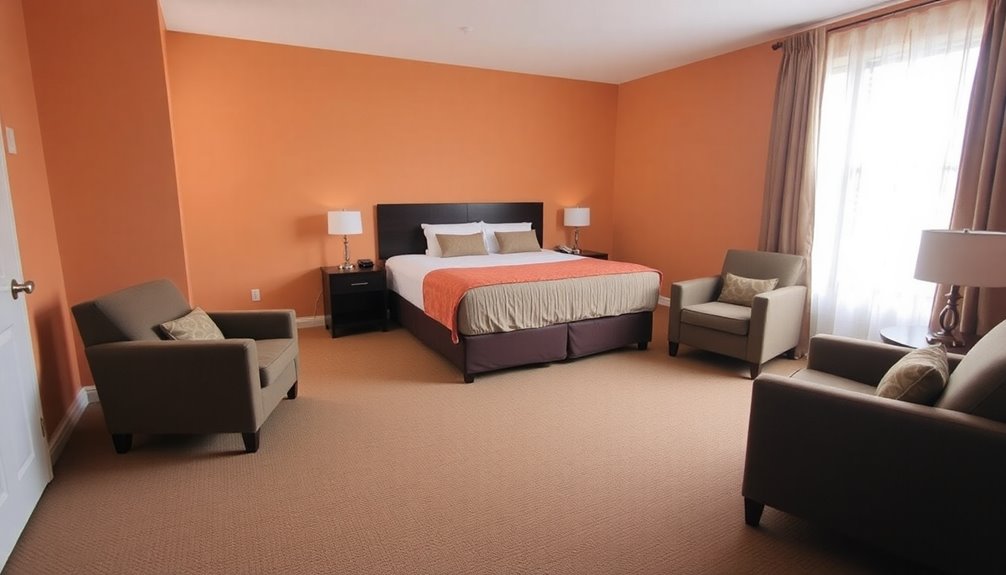
To keep your home safe and comfortable, maintain at least 6 inches of clearance around baseboard heaters. This distance prevents heat blockage and guarantees proper air circulation, enhancing your heating efficiency.
When placing furniture like bookcases or cabinets, be mindful to keep them at least 6 inches away. If your furniture has feet, it helps airflow underneath, which is essential for peak heating. Avoid low-hanging cabinets that can obstruct airflow. Additionally, ensuring that furniture is kept at a safe distance helps mitigate the risk of increased fire hazards.
Regularly check the area around heaters to verify nothing has fallen in, as this can lead to cold spots and higher energy costs. By maintaining proper clearance, you reduce fire risks and protect your furniture from heat damage, creating a more comfortable living space.
Avoid Flammable Materials
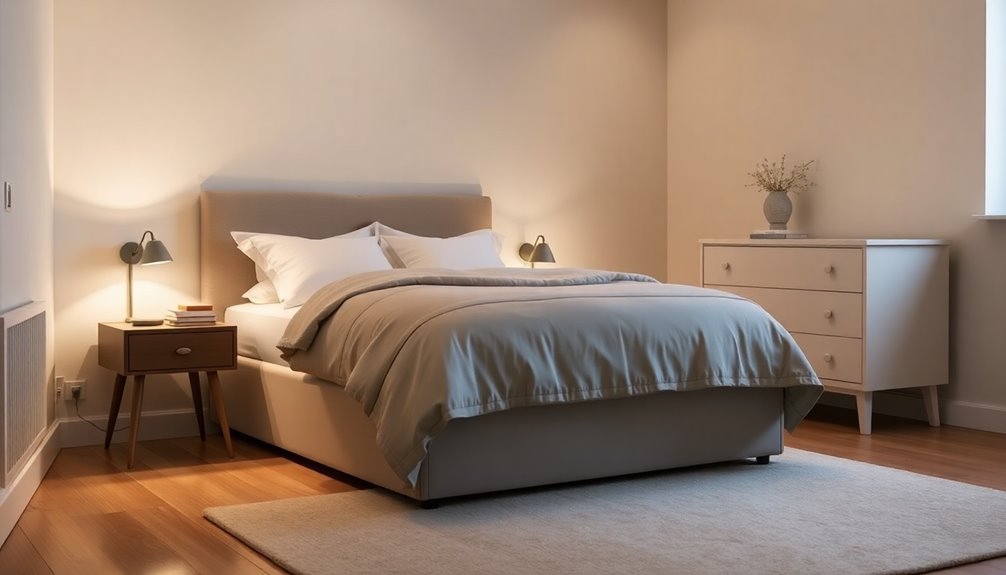
When arranging your bedroom, it's essential to be aware of flammable fabrics around baseboard heaters. Fabrics like curtains and drapes can pose a serious fire risk if they're too close, so consider heat-resistant furniture options that keep safety in mind. Always maintain a safe distance to protect both your belongings and your home. By understanding the importance of maintaining clearance around baseboard heaters, you can ensure a safer and more comfortable living space.
Flammable Fabrics Awareness
Keeping your bedroom safe from fire hazards is essential, especially around baseboard heaters. To minimize risks, you need to be aware of the fabrics and materials in your space. Flammable fabrics like silk, polyester, and wool should be kept away from these heaters. Additionally, consider the type of heating system in your home, as it affects how you should arrange furniture and fabrics around baseboard heaters. It's also wise to remember that regular maintenance of your heating system can help prevent overheating and reduce fire risks.
Here are some quick tips to enhance your safety:
- Always maintain a distance of at least 6 inches between flammable items and heaters.
- Avoid placing paper products, bedding, and clothing near baseboard heaters.
- Regularly inspect and clean your heaters to prevent dust buildup that can lead to overheating.
Heat-Resistant Furniture Options
Choosing heat-resistant furniture is essential for maintaining safety in a bedroom with baseboard heaters.
Opt for metal pieces like aluminum or powder-coated steel, which remain cool and resist rust. Aluminum is lightweight, making it easy to rearrange furniture as needed.
Ceramic and glass are also excellent choices; ceramic is non-flammable, while glass won't ignite, though it can shatter if dropped.
For a more casual look, consider synthetic materials like synthetic wicker or HDPE, both of which withstand heat and moisture without fading or cracking.
If you prefer wood, go for durable hardwoods like teak or eucalyptus, as they resist heat and moisture well.
Circulation Is Key
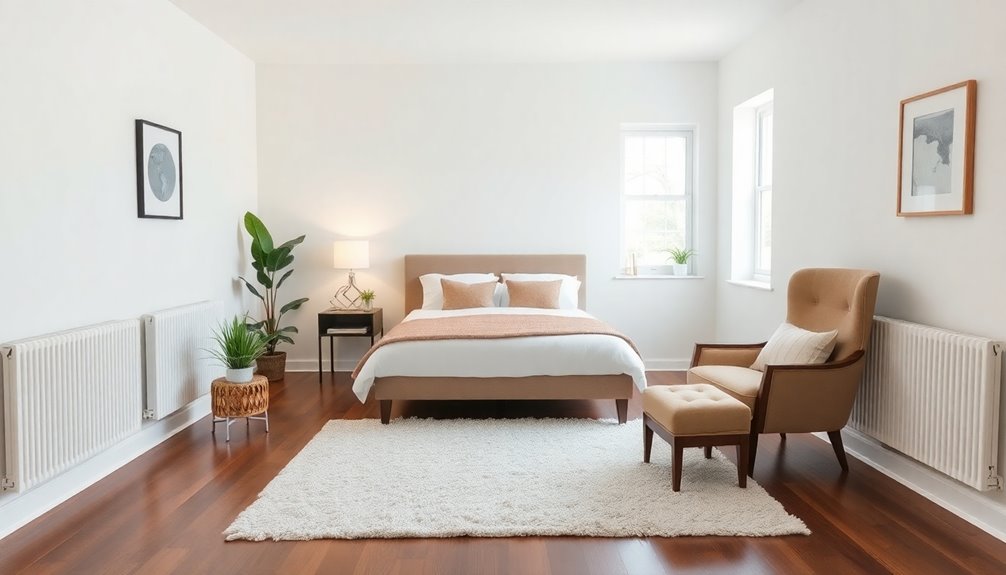
To guarantee your bedroom stays warm and comfortable, maintaining proper air circulation around baseboard heaters is essential. Blocked airflow can lead to cold spots and increase your energy costs. Make certain to keep at least 6 inches of clearance between furniture and the heaters. This not only prevents heat blockage but also minimizes fire risks. Proper heat distribution is vital, as noted by the rule of thumb of 10 watts of heat per square foot.
- Regularly check for flammable materials near the heaters.
- Use heat-resistant stands to keep furniture elevated.
- Clean vents periodically to guarantee efficient airflow.
Use Vent Deflectors
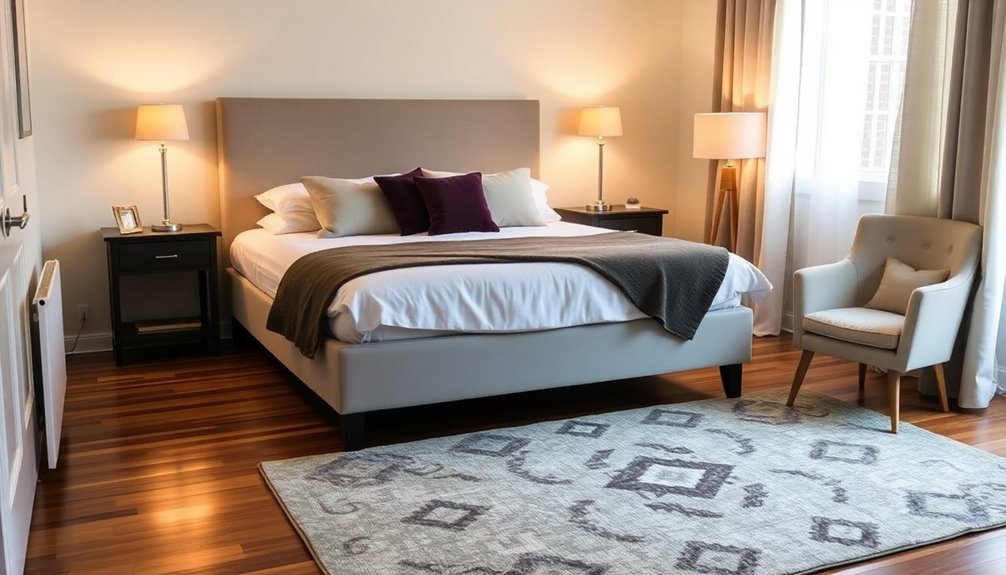
Using vent deflectors is a smart way to direct airflow effectively in your bedroom. By positioning them properly, you can enhance heating efficiency and guarantee that every corner of the room feels comfortable. This simple addition can make a noticeable difference in your home's climate control. Additionally, choosing vent deflectors made of steel with a black finish ensures durability and complements modern decor.
Directing Airflow Effectively
When you want to guarantee efficient heating in your bedroom, vent deflectors can be a game changer.
These handy tools control airflow by directing it up or down, improving circulation around your baseboard vents. Installing them is a breeze with included magnets, and they fit registers between 15 and 25 inches, making them versatile for most setups. Additionally, using vent deflectors can help address issues with heat transfer dynamics, ensuring that heated air is evenly distributed throughout the room.
Here are some benefits of using vent deflectors:
- Improved circulation: Guarantees even distribution of heated air.
- Energy efficiency: Helps reduce heating costs.
- Safety: Prevents overheating and fire hazards.
Enhancing Heating Efficiency
Vent deflectors are a simple yet effective way to enhance heating efficiency in your bedroom.
These handy tools redirect airflow from blocked vents, ensuring warm air reaches every corner of the room. Available in baseboard and wall designs, they're usually made of adjustable curved plastic, making installation a breeze—often using magnets, no tools required. Additionally, using indexed annuities can provide a balance between risk and reward, which can help you manage long-term financial stability as you invest in home improvements.
By positioning a vent deflector, you can shift air from beneath or behind furniture, maximizing comfort and minimizing energy costs. It's crucial to keep furniture at least 6 inches away from baseboard heaters to allow proper airflow. Additionally, using deflectors can contribute to improving HVAC efficiency by balancing temperature across rooms and minimizing hot and cold spots.
Plus, these affordable solutions range from $6 to $30, making them a cost-effective way to maintain an efficient heating system in your home.
Regular Maintenance
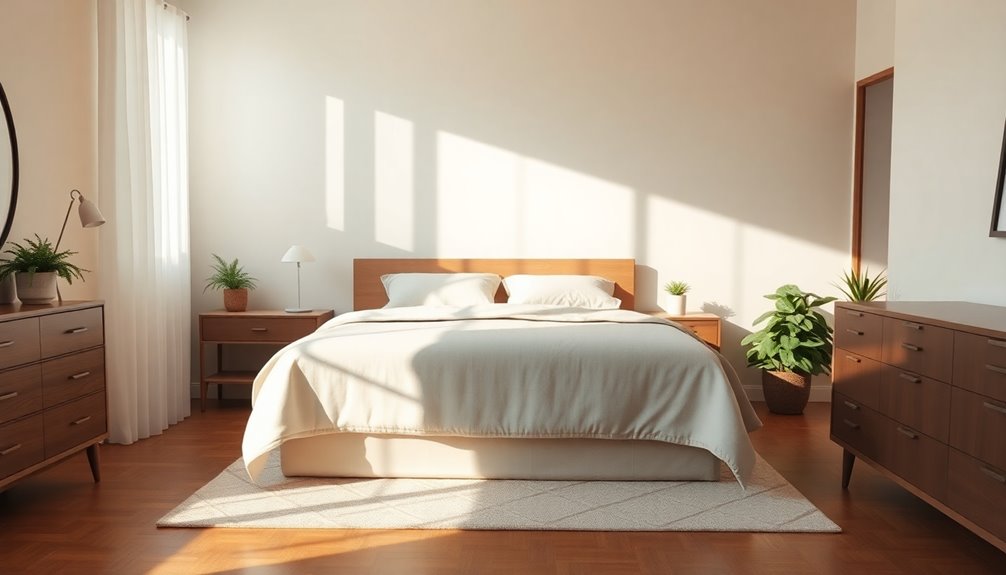
To keep your baseboard heaters running efficiently, regular maintenance is essential. Start by turning off the power at the circuit breaker and allowing the units to cool completely. This guarantees your safety and prevents burns.
Next, remove and clean the front cover to eliminate dust and debris, taking care not to soak it.
Here are a few maintenance tips to keep in mind:
- Inspect and straighten the heating element fins to guarantee proper airflow. Regular cleaning of the unit can also contribute to better air quality, enhancing the overall indoor environment.
- Use a dry microfiber cloth or paintbrush to clean out any visible debris.
- Regularly check everything to maintain efficiency and prevent blockages. Additionally, cleaning your baseboard heaters not only helps to enhance heating efficiency but also contributes to better indoor air quality.
Space-Saving Tips
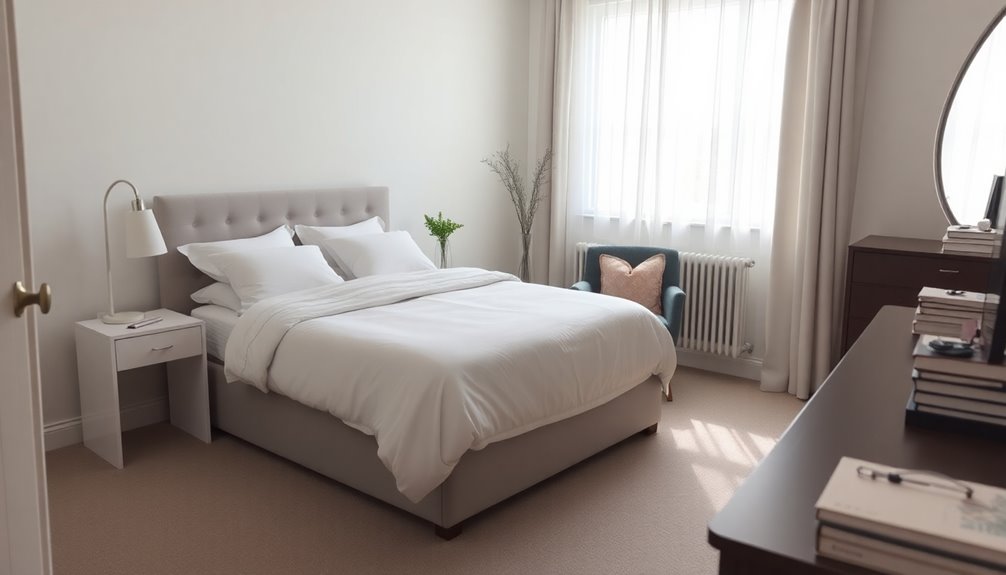
Arranging bedroom furniture around baseboard heaters can be tricky, but with some thoughtful space-saving strategies, you can create a comfortable and functional layout.
First, maintain at least 6 inches of clearance around heaters to guarantee proper air circulation and minimize fire risks.
Optimize your furniture placement by centering the bed on the most visible wall and considering floating shelves instead of traditional bedside tables. Incorporating multi-purpose furniture can further enhance your layout's efficiency and functionality. Consider using sustainable materials for furniture to promote eco-friendly design while enhancing visual appeal.
Choose space-efficient furniture with legs that allow airflow, and consider multi-purpose items like storage ottomans.
To create the illusion of more space, use mirrors to reflect light and cover under-bed storage with a stylish valance.
These tips will help you maximize your space while keeping your room cozy and inviting.
Frequently Asked Questions
What Are the Best Materials for Furniture Near Baseboard Heaters?
When choosing materials for furniture near baseboard heaters, opt for non-flammable options like aluminum and synthetic wicker.
They're lightweight and won't retain heat. You can also consider heat-resistant choices like HDPE and teak, which resist warping.
For fabrics, go with moisture-resistant or fire-treated materials to minimize risk.
These selections not only guarantee safety but also provide low-maintenance benefits, making them ideal for your space while keeping it stylish and functional.
How Often Should I Clean My Baseboard Heaters?
You should clean your baseboard heaters regularly to keep them efficient and safe. Aim for deep cleaning once a year, with quick wipe-downs every few months.
If you have pets, clean them twice a year. Always check for visible debris and reduced efficiency, which indicate it's time to clean.
Remember to clean before and after the heating season to maintain peak performance. A little maintenance goes a long way in ensuring your comfort!
Can I Use Rugs Near Baseboard Heaters?
You can use rugs near baseboard heaters, but you should be cautious.
Rugs can obstruct airflow, reducing heating efficiency and creating hot spots. It's essential to maintain a clearance of at least six inches to minimize fire risks.
Choose rugs made from non-flammable materials and regularly check them for heat damage.
If possible, position rugs away from the heaters to guarantee proper ventilation and safety in your space.
What Types of Furniture Are Safest Near Heaters?
When you're choosing furniture near heaters, opt for heat-resistant materials like metal or hard plastic.
Lightweight items, such as small tables or plants, work well too.
Avoid placing flammable fabrics or heavy furniture close to the heater, as they can block airflow and create fire hazards.
Make certain to maintain at least 6 inches of clearance to guarantee efficient heating and prevent damage to your furniture.
Regularly check for any signs of heat exposure.
How Do I Know if My Heater Is Working Efficiently?
Think of your heater as a diligent worker, tirelessly keeping your home warm.
To know if it's working efficiently, pay attention to the warmth it produces. If you find cold spots or your energy bill skyrockets, it's time to investigate.
Clean the vents regularly and guarantee nothing blocks airflow.
Also, monitor its performance; if it's constantly cycling on and off, something might be amiss.
Trust your instincts and keep your home cozy!
Conclusion
By arranging your bedroom furniture thoughtfully around baseboard heaters, you're not just creating a cozy space; you're weaving a tapestry of comfort and safety. Think of the heaters as the heart of your room, pumping warmth and life. Keep the path clear for warmth to flow freely, and avoid flammable materials, just as you'd guard a precious flame. With these space-saving tips, you'll transform your bedroom into a sanctuary where both style and safety coexist beautifully.
